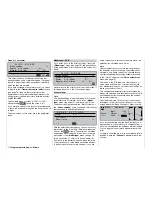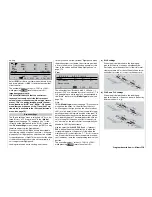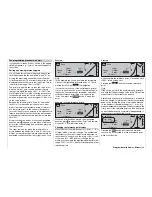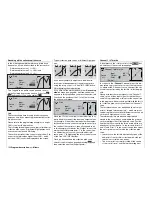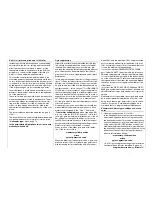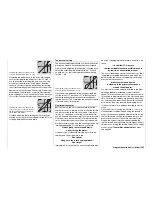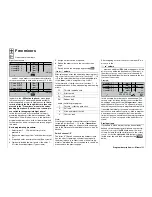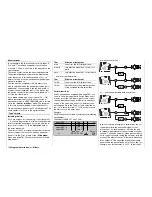
124
Program description:
Mixers
Rounding off the collective pitch curve
In the following example the reference points have
been set as follows, as described in the last section:
Reference point value 1 to +50%,
Reference point value 2 to +90% , and
Reference point value 3 to +0%.
»Normal «
Pitch
Input
Curve
off
Point
Output
This “jagged” curve profi le can be rounded off auto-
matically simply by pressing a button. Press the
EN-
TER
button next to the “curve symbol”
:
»Normal «
Pitch
Input
Curve
on
Point
Output
Note:
The curves shown here are only for demonstration
purposes, and by no means represent realistic collec-
tive pitch curves.
Please refer to the programming examples on pages
199 for “real world” applications.
The following three diagrams show typical three-point
collective pitch curves for different fl ight phases, such
as hover, aerobatics and 3-D fl ying.
The vertical bar refl ects the current stick position. Ple-
ase note that trim values higher than +100% and lo-
wer than -100% cannot be displayed on the screen.
Typical collective pitch curves for different fl ight pha-
ses:
It can be very helpful to adjust each individual re-
ference point independently of the adjacent points
using the rotary control or a “free” INC / DEC button.
Note regarding the marker button:
If you have set the marker button in the »
Base setup
model
« menu (see page 66), a dotted vertical line
appears in this graph when you press the button; this
line shows the position of the C1 stick the last time
the button was pressed:
-30%
-30%
m
OU
T
P
U
T
--
+
1
10
0
?
»Normal «
Pitch
Input
Curve
off
Point
Output
Move the C1 stick (solid line) to the marker line in or-
der to be able to read off the input and output values.
For example, if the marker line indicates the momen-
tary hover point, and you wish to place this exactly in
the centre of the control arc, then all you need to do
in this example is to transfer the “Output” value of the
marker line to Reference point “1” in the control cen-
tre. Alternatively, of course, you could adjust refe-
rence point “1” in fl ight using the rotary control or one
of the “free” INC / DEC buttons.
Once you have defi ned the collective pitch curve,
switch to the fi rst screen page by pressing
ESC
, and
then select the next line (if appropriate):
Channel 1
Throttle
A brief press on the rotary control or the
ENTER
but-
ton switches to the second screen page.
?
m
OU
T
P
U
T
--
+
1
10
0
-60%
-60%
»Normal «
Channel 1
Input
Curve
off
Point
Output
Throttle
In contrast to the »
Channel 1 curve
« menu this dis-
play refers only to the control curve of the throttle ser-
vo, whereas the “Channel 1 curve” affects
all
the ser-
vos which are affected by the throttle / collective pitch
stick.
Please note that the output signal of the “Channel 1
curve” option acts as input signal for the throttle cur-
ve which is programmed at this point: the vertical line
in the diagram, which moves in parallel with the thrott-
le / collective pitch stick, follows the actual Channel 1
curve.
The throttle curve can also be defi ned by up to eight
points – termed “reference points” – which are positi-
oned along the full stick travel; different curves can be
set for each fl ight phase if you so wish.
The reference points are defi ned, adjusted and
erased in the usual way, as explained in the previous
section relating to the collective pitch curve. First de-
fi ne the throttle curve with the three points which are
already set in the software, i. e. the two end-points “L”
and “H” and Point “1” in the control centre, then adjust
the motor power curve to match the collective pitch
curve:
• In every case the throttle must be fully open at the
end-point of the throttle / collective pitch stick (ex-
ception: auto-rotation; see below).
• The hover point is normally located at the centre
of the control travel, and the throttle setting must
–
+
–
+
–
+
L
H
Control travel
L
H
Control travel
L
H
Control travel
Hover
Aerobatic
3D flying
Summary of Contents for mx-24s
Page 1: ...1...
Page 19: ...19 For your notes...
Page 35: ...35 For your notes...
Page 41: ...41 41 For your notes...
Page 57: ...57 For your notes...
Page 63: ...63 63 For your notes...
Page 69: ...69 69 For your notes...
Page 85: ...85 85 For your notes...
Page 99: ...99 For your notes...
Page 143: ...143 For your notes...
Page 191: ...191 For your notes...
Page 212: ...212 212 For your notes...
Page 213: ...213 213 For your notes...
Page 214: ...214 For your notes...
Page 216: ...216...





